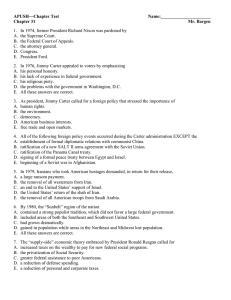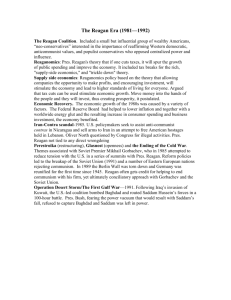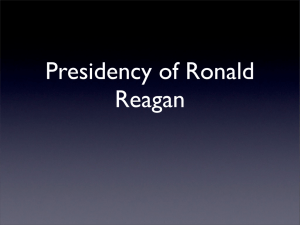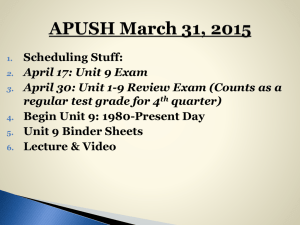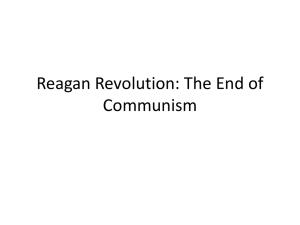Foreign Policy after Vietnam and the End of the Cold War
advertisement
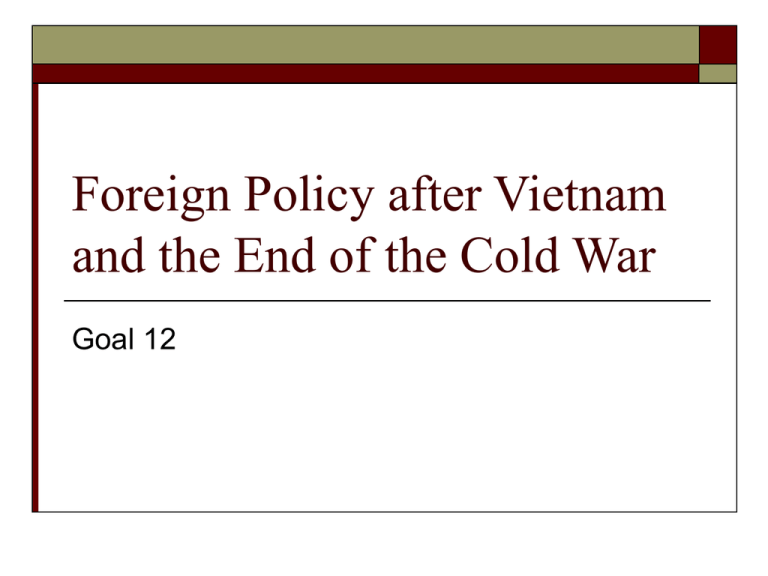
Foreign Policy after Vietnam and the End of the Cold War Goal 12 Essential Idea The Reagan Doctrine led to the end of the Cold War. Carter Elected Ford’s Action: Ford pardoned Nixon Why Ford did it: so the country could move on Result: Jimmy Carter easily beat Ford in the Election of 1976 Zionist Movement Zionism – the idea that Jews should have a homeland The Holocaust helped the Zionist Movement gain strength Creation of Israel In 1948, land was set aside from Palestine by the United Nations to create Israel Middle-East Conflict This area is still a source of conflict between Palestinians, who are Arab and Muslim, and Israelites, who are Jews Creating Israel Yom Kippur War The Yom Kippur War pitted Syria and Egypt (Arab) against Israel (Jewish) Camp David Accords – moderated by President Carter, Israel and Egypt agreed to peace Yom Kippur War Arabs Unhappy with the Peace It was the first time an Arab/Muslim country recognized Israel as a country Egypt's leader, Anwar Sadat, was later assassinated by Arabs Covert Operations in Iran 1953 Iran and the Soviet Union began negotiating a deal to trade oil America was worried that Iran would become communist The Rule of the Shah The CIA secretly overthrew the government and installed the Shah (King) of Iran 1979 Iran had a revolution The Shah was removed The Ayatollah Khomeini, a fundamentalist Muslim, was put in power Iranian Hostage Crisis Iranian Hostage Crisis 52 Americans were taken hostage in response to Carter helping the Shah They were held for 444 days until Carter was replaced by Ronald Reagan Foreign Policy in Iran Détente Foreign Policy under Nixon: Détente – have a “live and let live” approach with communist countries in order to ease Cold War tension Carter Abandons Détente Foreign Policy under Carter: Carter strongly believed in human rights, which he thought the Soviets violated Soviet War in Afghanistan: When the Soviets went to war with Afghanistan, America sided with Afghanistan Helping Afghanistan Against the Soviet Union Carter boycotted the 1980 Olympics in Moscow America sent aid to Afghan fighters, including Osama Bin Laden The Iran-Contra Scandal The Problem: Iranian Hostage Crisis What Reagan secretly did: in exchange for the hostages, Reagan sold weapons to Iran What Reagan did with the money: used the money to fund Contras, who were anticommunists in Nicaragua (breaking détente) The Iran-Contra Scandal Why it was a scandal: Iran was considered an enemy (you don’t sell weapons to enemies!) Congress had forbidden giving aid to Contras (even though they were anticommunist, America was practicing détente at the time) Iran-Contra Scandal Reagan’s Foreign Policy 1. Containment What it said: prevent communism from spreading 2. Truman Doctrine What it said: protect Greece and Turkey from communism 3. Eisenhower Doctrine What it said: protect the Middle East from communism 4. Détente What it said: make peace with communism (“live and let live”) The Reagan Doctrine 5. Reagan Doctrine What it said: DESTORY COMMUNISM The Difference: Reagan did not want to “put up with” communism, he wanted to end it completely (destroy it) Enforcing the Reagan Doctrine Strategy #1: “Peace through Strength” Reagan authorized a massive build up of the military Reagan hoped the Soviet Union’s economy would collapse while trying to keep up the arms race Peace through Strength Strategic Defense Initiative – nicknamed “Star Wars”, this program sought to build weapons that could intercept missiles (in space) Was this realistic at the time? Proxy Wars Strategy #2: Proxy Wars Proxy wars – rather than fight the Soviet Union directly, America would help countries fighting the Soviet Proxy Wars Korea, Vietnam, and Afghanistan were proxy wars This kept America and the Soviet Union from fighting directly and starting nuclear war The Reagan Doctrine Where did we fight in the 1950s? Where did we fight in the 1960s? Where is Afghanistan? What can be said about all the places we fought/were involved in during the Cold War? Soviets Near Collapse New Soviet Leader: Mikhail Gorbachev Change #1: Perestroika – allowed for more economic freedom Change #2: Glasnost – allowed more freedom of speech and religion Reagan Keeps the Pressure On 1985 (Germany) Reagan visited West Berlin, aware that the Soviet Union was near collapse In a speech, Reagan demanded Gorbachev tear down the Berlin Wall Reagan’s Speech Tiananmen Square 1989 (China) Chinese students held a massive protest at Tiananmen Square The world watched as the students were attacked by the Chinese military Chinese Protest Communist Rule Freedom vs. Oppression The Iron Curtain Raises 1989 (Eastern Europe) Eastern European countries began having revolutions Communist governments were turned into democratic governments Fall of the Berlin Wall 1989 (Germany) The Berlin Wall was torn down Germany was reunited as a democratic country Soviet Union Collapses, Cold War Ends 1991 (Soviet Union) The Soviet Union collapsed (Russia again!) Boris Yeltsin became president The Cold War ended The Cold War Ends What was the effect of the Reagan Doctrine?

